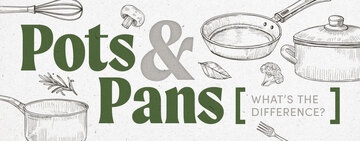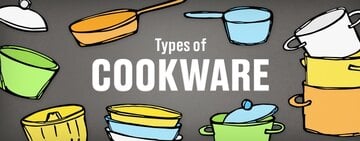Colander vs Strainer
Colanders and strainers are two practical kitchen tools that sometimes get mixed up. Did you know you will get better results with your recipes if you choose the right one for the job? We’ll cover the differences between colanders and strainers and also introduce you to another helpful tool called a chinois.
Colander or Strainer?
You can spot the difference between colanders and strainers by looking at the type of perforations. Colanders have large holes for draining liquid, and strainers have fine holes or mesh for catching small solids. Colanders feature a large, bowl-like shape and often have a base so they can sit directly in your sink basin. Strainers are a hand-held tool with a mesh basket designed for dipping into pots or straining particles from liquid. Reach for the colander if you need to wash fruits and veggies, but use a strainer for more delicate tasks like separating solids from your soups and sauces.
What Is a Colander?
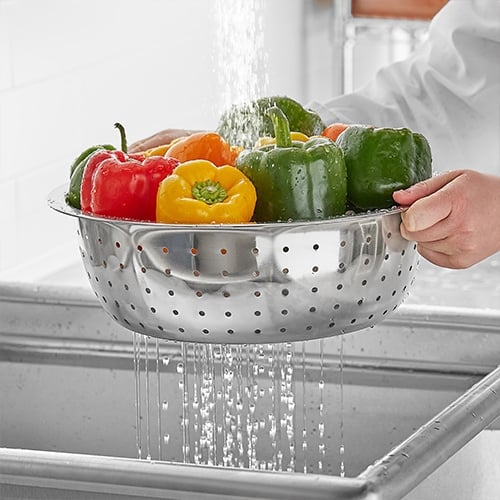
A colander is a perforated bowl that usually features two handles and a base. There are small colanders designed for rinsing small items like berries, and there are extra large colanders made for draining water from batches of pasta. You’ll also find colanders made from several different materials like plastic, stainless steel, or aluminum.
What Is a Colander Used For?
The main purpose of a colander is to drain liquids from foods or to rinse foods. The large perforated holes in a colander make it best for the following applications:
- Draining Water from Pasta - Place a large colander in a clean sink basin and pour your cooked pasta with water into the colander. Don’t forget to save a little pasta water for making your sauce! Also, don’t rinse your pasta or you will remove the starch that makes sauce cling deliciously to each noodle.
- Rinsing Produce - One of the most common uses for a colander is washing produce. Place the colander in the clean sink basin and turn on the running water. Use this method for washing lettuce, apples, potatoes, and tomatoes.
- Draining Canned Foods - Canned foods usually come packed in liquid. In some cases, you may want to drain or reserve that liquid for another use. For example, the liquid leftover from a can of beans is called aquafaba and can be used in other recipes. If you want to save the liquid, place the colander over a large bowl and pour the contents of the can into the colander. Or if you simply want to rinse away any residual liquid, place the colander in the sink and follow up by rinsing the can’s contents with running water.
Types of Colanders
Colanders are pretty straight-forward tools, but there are a couple of different types that can be used for specific applications:
- Chinese Colanders - You’ll recognize a Chinese colander by its large perforated holes. These colanders have larger holes than a standard colander and no handles, which makes them easier to stack for compact storage. If you use a large number of colanders in your foodservice kitchen, the Chinese colander might work best for you.
- Two-Handle Colanders - Standard two-handle colanders are very common and can be used for a variety of tasks. The two handles make these colanders very easy to carry to and from the sink.
- Vegetable Colanders - Vegetable colanders feature a deep bowl that can hold large quantities of fruits and veggies.
What Is a Strainer?
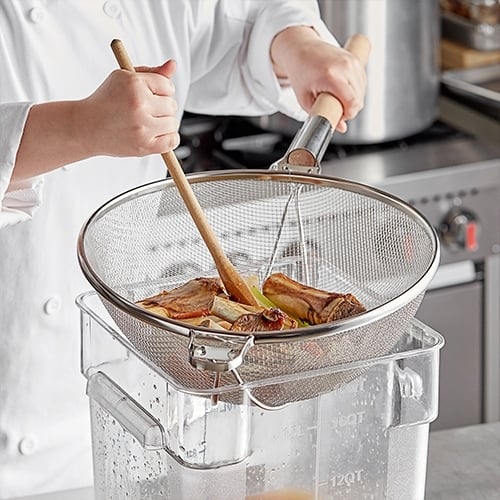
A strainer, also sometimes called a sieve, is a kitchen tool made with fine mesh that catches solids and particles. Instead of the large holes in a colander, the fine mesh of a strainer can be used for greater filtration. Strainers often have a long handle that can be used with one hand. This comes in handy when you need to remove pulp, seeds, or other solid material from your dishes.
Strainer Uses
Strainers can do many tasks that a colander can’t, thanks to their fine mesh construction. Reach for a strainer when you need greater filtration for these types of tasks:
- Remove Seeds and Pulp - Remove seeds and pulp from fruit-based sauces or liquids.
- Remove Herbs, Tea Leaves, or Spices - Use a strainer to catch sprigs of herbs, soup bones, and whole spices in your stocks or broths. You can also strain tea leaves from your brewed tea.
- Rinse Rice - Rice grains fall through the large perforated holes of a colander, so the mesh of a strainer is more suitable for rinsing rice before you cook it.
- Skim Solids from Hot Oil - Some strainers are made to be dipped into hot oil to lift and strain foods.
- Blanching Pasta or Vegetables - Strainer baskets can be dipped into boiling water to cook or blanch vegetables and pasta.
Types of Strainers
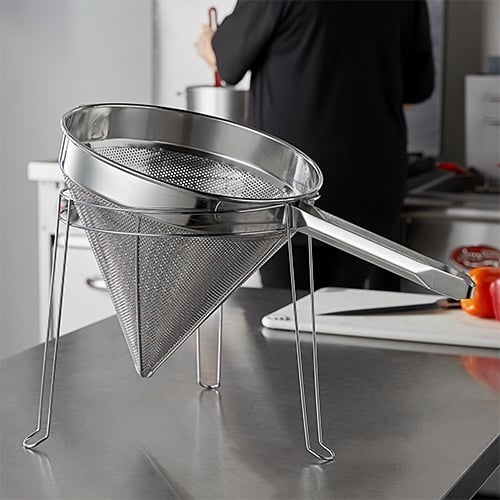
There are different types of strainers you can use for specialized tasks.
- China Cap Strainer - A china cap strainer has a conical basket made of mesh that is perfect for removing seeds from soft foods. A cone-shaped pestle can be pushed into the sieve to move food through the mesh.
- Chinois Strainer - Sometimes confused with a China cap strainer, a chinois strainer has finer mesh that works with purees and sauces when you want a very smooth texture.
- Strainer Basket - Strainer baskets have a deep cylinder shape that is meant to be dipped into a pot of simmering water. These strainers are meant to hold pasta and vegetables so they can be blanched or cooked and then pulled out of the water quickly.
- Cocktail Strainer - Don’t forget about cocktail strainers! These small mesh strainers feature a small mesh basket that fits over a glass or cocktail shaker to strain ice and muddled herbs.
Strainer Substitute
If you find yourself in need of a strainer, but don't have one on hand, there are some kitchen tools you can can use instead. Try one of these common items as a strainer substitute:
- Cheesecloth
- Perforated sheet pan
- Slotted spoon
- Coffee filter
What Is a Chinois?
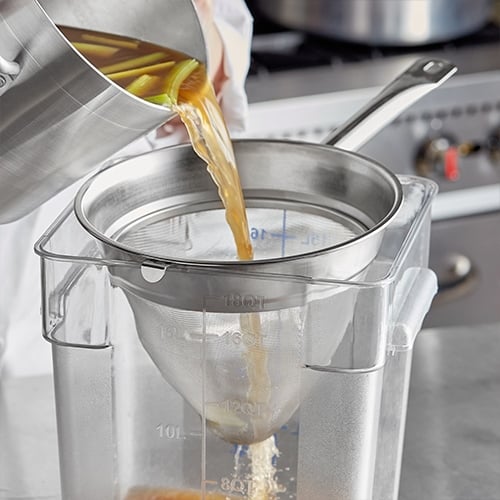
A chinois strainer is a special type of strainer made with extremely fine mesh for catching the smallest particles. It has a conical basket that can be used with a small pestle to push foods like custards through the finely woven mesh.
Chinois vs China Cap
The chinois strainer and China cap strainer look very similar, but the main difference is that a chinois has a finer mesh basket. Both strainers have a conical shape, can be used with a pestle, and often come with a stand to hold them in place.
If you've been using a colander for all these tasks, now you know there's a better tool for straining small solids from your recipes. Rinse rice, strain stocks and broth, and make smooth, creamy sauces with a kitchen strainer. Keep a few colanders on hand for washing produce, draining canned foods, and draining water from cooked pasta.


